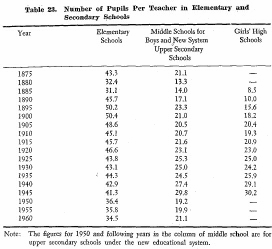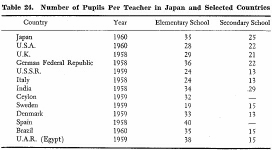| Home > Policy > White Paper, Notice, Announcement > White Paper > JAPAN'S GROWTH AND EDUCATION 1963 > CHAPTER |
||
The numbers of pupils per teacher in Japanese schools are shown by school level at five-year intervals for the period 1875-1960.
Pupil-teacher ratios in elementary schools were consistently high from 1890 to 1920 but have decreased continuously and materially since 1920. To raise the national educational standard, the greatest effort was made and elaborate plans worked out for the training of teachers, which resulted in increasing the number of teachers at a rate greater than that of the increase in the number of pupils. Actually, the lowering of the pupil-teacher ratio began in 1905, although increases were subsequently experienced in 1915, 1920 and 1935. After the war, the laws providing the fixed number of pupils per class and per teacher were enacted, and the ratio has decreased considerably as a result.
The pupil-teacher ratios for middle schools, new system upper secondary schools and girls' high schools, though much lower than for elementary school, increased almost continuously during the period from 1875 to 1945.Tlais is a result of the almost continuous, heavy and recently accelerated increase in the popularization of secondary education in Japan. Enrollment increases have not been met by corresponding increases in appropriations of funds at either the local or national level for construction of new facilities or for the training of additional teachers. Since tlae new school system was adopted after the war, the pupil-teacher ratio at upper secondary schools has become approximately 20, which shows that the ratio has much improved comparing with that of middle schools and girls' high schools in the past.

The number of pupils per teacher in elementary and lower secondary schools in foreign countries is, generally speaking, smaller in the developed countries and larger in such developing countries as Spain, India, etc., from which one can see the in those developing countries it is not yet possible to train the required number of teachers. The pupil-teacher ratios of Japan, although considerable improvement has already been made in the past, still requires much improvement to meet the demands of increased popularization of education.

| Back to Top | MEXT HOME |